Themed collection Supramolecular Gels in Crystal Engineering

Supramolecular gels in crystal engineering
Welcome to this CrystEngComm themed issue entitled “Supramolecular gels in crystal engineering.”
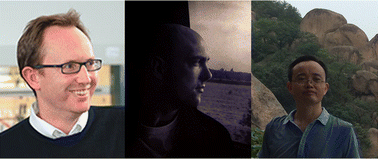
CrystEngComm, 2015,17, 7976-7977
https://doi.org/10.1039/C5CE90184G
Crystal networks in supramolecular gels: formation kinetics and mesoscopic engineering principles
The formation of crystal networks/patterns is subject to the kinetically favored selection in the process of crystallization.
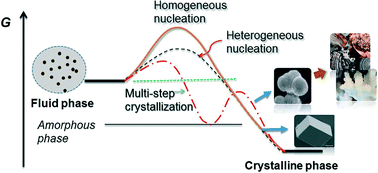
CrystEngComm, 2015,17, 7986-8010
https://doi.org/10.1039/C5CE00854A
Transformation of rigid metal–organic frameworks into flexible gel networks and vice versa
New conceptual bridges allows the connection between metal–organic frameworks (hard) and gel-based materials (flexible).

CrystEngComm, 2015,17, 7978-7985
https://doi.org/10.1039/C5CE01032B
Influence of chiral ligands on the gel formation of a Mg(II) coordination polymer
The self-assembly of Mg2+ ions and N-(7-hydroxyl-4-methyl-8-coumarinyl)-alanine furnished mesoscale assembled structures as microfibres with well-aligned nanofibres or a randomly cross-linked gel network depending on the chirality of the amino acid and the pH of the solution.
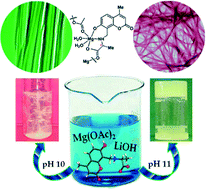
CrystEngComm, 2015,17, 8011-8014
https://doi.org/10.1039/C5CE00662G
Synthesis, characterization and spectroscopic studies of luminescent L-valine modified alkynyl-based cyclometalated gold(III) complexes with gelation properties driven by π–π stacking, hydrogen bonding and hydrophobic–hydrophobic interactions
A series of luminescent L-valine modified alkynyl based cyclometalated gold(III) complexes are synthesized and characterized.
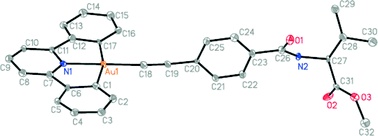
CrystEngComm, 2015,17, 8153-8162
https://doi.org/10.1039/C5CE01136A
Multi-component supramolecular gels for the controlled crystallization of drugs: synergistic and antagonistic effects
Active pharmaceutical ingredients (APIs) with no carboxylic acid in their structure readily crystallize inside the organogels formed by G2-Lys dendron and aliphatic amines. In contrast, APIs with carboxylic acid prevent both the gelation of the mixture and the crystallization of the API.

CrystEngComm, 2015,17, 8146-8152
https://doi.org/10.1039/C5CE01293G
A new small molecule gelator and 3D framework ligator of lead(II)
A new allene dicarboxylate ligand reacts with hydrated lead(II) acetate in DMF to yield either a crystalline 3D framework or a metallogel dependent on the reaction temperature.
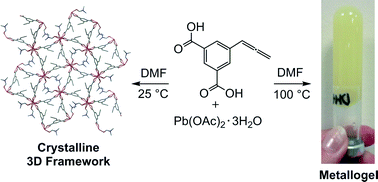
CrystEngComm, 2015,17, 8139-8145
https://doi.org/10.1039/C5CE01689D
Selective gelation of N-(4-pyridyl)nicotinamide by copper(II) salts
We report the gelation properties of the copper(II) complexes of N-(4-pyridyl)nicotinamide (4PNA). Gelation was observed for the copper(II) complexes of 4PNA, whereas the manganese(II), iron(II), cobalt(II), nickel(II), cadmium(II) and zinc(II) complexes were not able to form metallogels.

CrystEngComm, 2015,17, 8130-8138
https://doi.org/10.1039/C5CE00901D
A two-component hydrogelator from citrazinic acid and melamine: synthesis, intriguing role of reaction parameters and iodine adsorption study
Melamine and citrazinic acid, upon solid-state grinding, produced a two-component gelator which selectively gelates water or a mixed-solvent system having water as one of the solvents. The dried hydrogel was porous and shows adsorption and storage of molecular iodine.
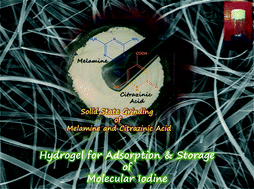
CrystEngComm, 2015,17, 8119-8129
https://doi.org/10.1039/C5CE01001B
Gel network incorporation into single crystals grown by decomplexation method
AgCl, AgI and CuCl single crystals grown by the decomplexation method in agarose gels incorporate gel networks.

CrystEngComm, 2015,17, 8113-8118
https://doi.org/10.1039/C5CE01085C
Synergetic functional properties of two-component single amino acid-based hydrogels
Hybrid hydrogels composed of the Fmoc-Tyr and Fmoc-DOPA building blocks present mechanical rigidity and redox activity.
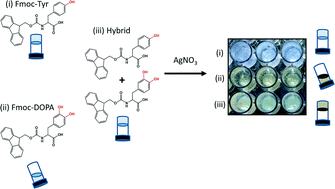
CrystEngComm, 2015,17, 8105-8112
https://doi.org/10.1039/C5CE01051A
Conducting hydrogel of a naphthalenetetracarboxylic dianhydride derivative and polyaniline: different electronic properties in gel and xerogel states
A drastic difference in the electronic properties of the gels and xerogels derived from the co-assembly of a naphthalenetetracarboxylic dianhydride derivative and polyaniline occurs due to the water-assisted diffusion of charges.
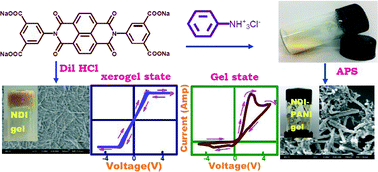
CrystEngComm, 2015,17, 8093-8104
https://doi.org/10.1039/C5CE00837A
Dissecting kinetic pathways to formation of the fibrillar objects in molecular gels using synchrotron FT-IR
Infra-red synchrotron radiation is used to monitor the formation of fibrillar networks as sols of simple gelators become gels.

CrystEngComm, 2015,17, 8085-8092
https://doi.org/10.1039/C5CE00733J
Development of protein seed crystals reinforced with high-strength hydrogels
Schematic diagram of the protocol for transporting seed crystals using a combination of high-strength hydrogel and macroseeding methods. Seeding experiments with hydrogel-grown seed crystals.
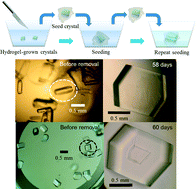
CrystEngComm, 2015,17, 8064-8071
https://doi.org/10.1039/C5CE00844A
Hydrogels formed from Fmoc amino acids
A number of Fmoc amino acids can be effective low molecular weight hydrogelators; we compare single crystal structures to fibre X-ray diffraction data.
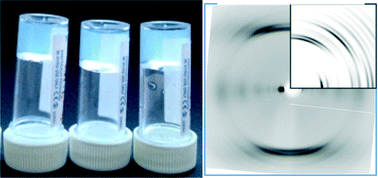
CrystEngComm, 2015,17, 8047-8057
https://doi.org/10.1039/C5CE00801H
Gelation or crystallization? Subtle balance of structural factors for assembly of DBA derivatives with methyl esters
The aggregation of a series of strained dehydrobenzoannulene derivatives with methyl ester groups is revealed.

CrystEngComm, 2015,17, 8079-8084
https://doi.org/10.1039/C5CE00778J
Protein crystallization in short-peptide supramolecular hydrogels: a versatile strategy towards biotechnological composite materials
Short-peptide supramolecular hydrogels are an interesting option to engineer protein crystals with modulated properties, which are useful not only for X-ray diffraction but also for multiple biotechnological applications.
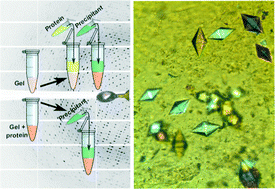
CrystEngComm, 2015,17, 8072-8078
https://doi.org/10.1039/C5CE00850F
Reactive organogels based on isoxazole esters: alkali metal ions selective gelation and crystallization
A methanol solution of a series of simple esters exhibited a response to different alkali bases, which formed solutions, organogels and crystals, respectively, when LiOH, NaOH and KOH were separately introduced.
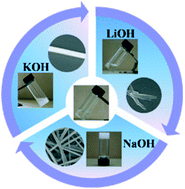
CrystEngComm, 2015,17, 8058-8063
https://doi.org/10.1039/C5CE00826C
Vesicle–tube–ribbon evolution via spontaneous fusion in a self-correcting supramolecular tissue
A reversible vesicle–tube–fibre transition was monitored in a cholesterol-based assembly with self-healing and self-correcting characteristics.

CrystEngComm, 2015,17, 8039-8046
https://doi.org/10.1039/C5CE00636H
12-Hydroxystearic acid SAFiNs in aliphatic diols – a molecular oddity
12-Hydroxystearic acid (12-HSA), a structurally simple and cost-effective low molecular weight organogelator, has been studied extensively.
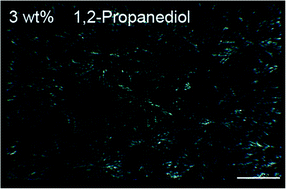
CrystEngComm, 2015,17, 8031-8038
https://doi.org/10.1039/C5CE00652J
A DAC tartrate-based gelator system featuring markedly improved gelation properties: enhancing lifetime and functionality of gel networks
The replacement of MeOH with DMSO in a DAC tartrate-based multicomponent gelator solution triggers the formation of organogels with enhanced stability and new functionalities.
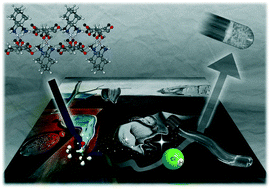
CrystEngComm, 2015,17, 8021-8030
https://doi.org/10.1039/C5CE00397K
About this collection
Guest Edited by Professor Stuart James (Queen’s University Belfast), Dr Gareth Lloyd (Heriot-Watt University) and Professor Jianyong Zhang (Sun Yat-Sen University), this issue focuses on the study and usage of supramolecular gels from a crystal engineering standpoint.